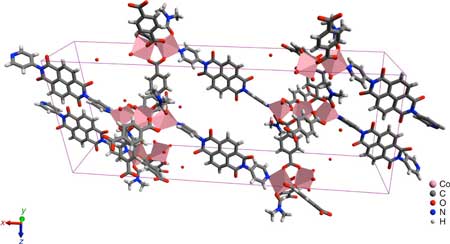| Posted: Dec 15, 2017 |
Record high photoconductivity for new metal-organic framework material
(Nanowerk News) An international team of scientists, from the University of Surrey, University of São Paulo (Brazil), the University of Warwick and the University of Grenoble-Alpes (France), has created a new metal-organic framework (MOF) that has shown record-high photo-conductivity levels for a material of its type.
|
 |
| A representation of MOF-CoNDI-py-2 crystal structure including its unit cell obtained by single-crystal XRD. Pink = cobalt, grey = carbon, white = hydrogen, blue = nitrogen and red = oxygen. The unit cell belongs to a C2/c monoclinic space group, water was modelled at 1/4 occupancy and its hydrogens are not shown for clarity. The structure shows the NDI-py molecules oriented in a layered fashion. The distances between NDI-py entities are 9.43 Å along the c-axis, 9.57 Å along the b-axis and 11.10 Å through the metal cluster. (© NPG)
|
|
The team published its findings in Nature Communications ("Electrical conduction modulated by light in a cobalt and naphthalene diimide metal-organic framework") where it reported that its MOF had a responsivity rate of 2.5 x 105 amperes per watt. The team’s MOF was made by using cobalt (II) ions and naphthalene diimides and acid ligands.
|
|
MOFs are compound materials that are made of ions and ligands to make 3 dimensional structures. MOFs are typically used to store gas and to separate and purify chemicals, but the scientists hope that their new discovery could lead to MOFs being used to make photoactive materials such as solar cells.
|
|
Professor Ravi Silva, Director of the Advance Technology Institute, said: “Metal Organic Frameworks have been gaining a tremendous amount of interest of late for their potential to be used for gas storage, sensing and catalysis – but it is clear that they could be used for so much more.
|
|
“This is a great example of how collaborating on an international scale can result in truly exciting discoveries that have the potential to change the direction of a number of industries.”
|

